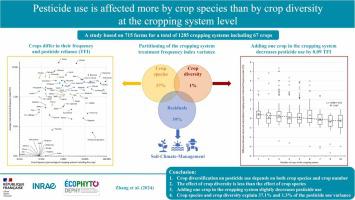当前位置:
X-MOL 学术
›
Eur. J. Agron.
›
论文详情
Our official English website, www.x-mol.net, welcomes your
feedback! (Note: you will need to create a separate account there.)
Pesticide use is affected more by crop species than by crop diversity at the cropping system level
European Journal of Agronomy ( IF 4.5 ) Pub Date : 2024-07-08 , DOI: 10.1016/j.eja.2024.127263 Yaoyun Zhang , Laurent Bedoussac , Chaochun Zhang , Wen-Feng Cong , Maé Guinet , Romain Nandillon , Nicolas Munier-Jolain
European Journal of Agronomy ( IF 4.5 ) Pub Date : 2024-07-08 , DOI: 10.1016/j.eja.2024.127263 Yaoyun Zhang , Laurent Bedoussac , Chaochun Zhang , Wen-Feng Cong , Maé Guinet , Romain Nandillon , Nicolas Munier-Jolain

|
Crop diversification has been shown to enhance a number of ecosystem services, including the regulation of insect pest, weed and pathogen pressure, thereby reducing pesticide needs and use. However, the quantitative relationship between crop diversification at the cropping system scale and pesticide use has been rarely addressed and is mostly supported by evidence from landscape scale or a few long-term experiments. Nevertheless, crop diversification can reduce pesticide use both as a result of the use of crops with lower inherent pesticide reliance (the effect of crop species), and as a result of the pest regulation effect due to the number of different crops in the cropping system (the effect of crop diversity). These two effects combine into a net effect at the cropping system scale which can be difficult to differentiate through experimental design or a modeling approach. We employed the DEPHY network database describing 1285 cropping systems and 67 cash crops to disentangle and quantify the two complementary effects on pesticide use at the cropping system level. Our results show that crop species and crop diversity explain 37.1 % and 1.3 % of the cropping systems total pesticide use variance respectively, while 38.7 % explained by other factors (Residuals). Excluding the crop species effect reveals that adding one crop in the cropping system decreases total pesticide use by 0.09 units of treatment frequency index, on average. Further studies are needed to shed light on the effects of crop species characteristics, as well as take into account other factors such as climate conditions.
中文翻译:

在种植系统层面,农药使用更多地受到作物种类的影响,而不是作物多样性的影响
作物多样化已被证明可以增强许多生态系统服务,包括控制害虫、杂草和病原体压力,从而减少农药的需求和使用。然而,种植系统规模上的作物多样化与农药使用之间的定量关系很少得到解决,并且大多得到景观规模或一些长期实验的证据的支持。然而,作物多样化可以减少农药的使用,因为使用固有农药依赖性较低的作物(作物种类的影响),以及由于种植系统中不同作物的数量而产生的害虫控制效果(作物多样性的影响)。这两种效应在种植系统规模上结合成净效应,很难通过实验设计或建模方法来区分。我们利用描述 1285 个种植系统和 67 种经济作物的 DEPHY 网络数据库来理清并量化种植系统层面对农药使用的两种互补影响。我们的结果表明,作物种类和作物多样性分别解释了种植系统总农药使用差异的 37.1% 和 1.3%,而其他因素(残差)则解释了 38.7%。排除作物种类的影响表明,在种植系统中添加一种作物可以平均减少 0.09 个处理频率指数单位的农药总使用量。需要进一步研究以阐明作物物种特征的影响,并考虑气候条件等其他因素。
更新日期:2024-07-08
中文翻译:

在种植系统层面,农药使用更多地受到作物种类的影响,而不是作物多样性的影响
作物多样化已被证明可以增强许多生态系统服务,包括控制害虫、杂草和病原体压力,从而减少农药的需求和使用。然而,种植系统规模上的作物多样化与农药使用之间的定量关系很少得到解决,并且大多得到景观规模或一些长期实验的证据的支持。然而,作物多样化可以减少农药的使用,因为使用固有农药依赖性较低的作物(作物种类的影响),以及由于种植系统中不同作物的数量而产生的害虫控制效果(作物多样性的影响)。这两种效应在种植系统规模上结合成净效应,很难通过实验设计或建模方法来区分。我们利用描述 1285 个种植系统和 67 种经济作物的 DEPHY 网络数据库来理清并量化种植系统层面对农药使用的两种互补影响。我们的结果表明,作物种类和作物多样性分别解释了种植系统总农药使用差异的 37.1% 和 1.3%,而其他因素(残差)则解释了 38.7%。排除作物种类的影响表明,在种植系统中添加一种作物可以平均减少 0.09 个处理频率指数单位的农药总使用量。需要进一步研究以阐明作物物种特征的影响,并考虑气候条件等其他因素。
















































 京公网安备 11010802027423号
京公网安备 11010802027423号